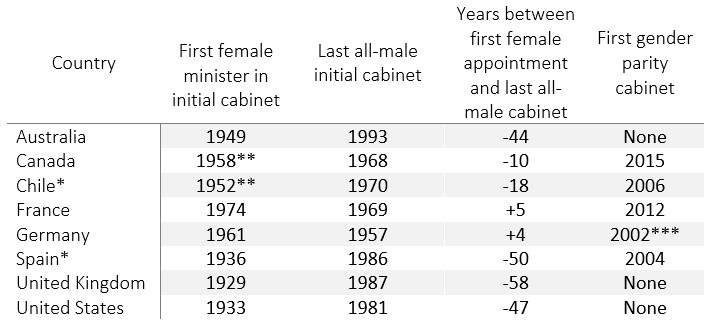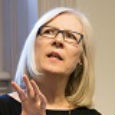Macron’s 50:50 gender-balanced cabinet: building on a concrete floor
The first cabinet appointed by new French President Emmanuel Macron has a 50-50 gender balance, with eleven of the 22 cabinet members being women. Karen Beckwith writes that Macron’s decision to appoint a gender-balanced cabinet should not have come as a surprise. Drawing on research in seven separate democracies with her colleagues Susan Franceschet and Claire Annesley, she illustrates how an informal ‘concrete floor’ for women’s participation in cabinets is now apparent.

Outgoing culture minister Audrey Azoulay (right) hands over to Françoise Nyssen at the Ministère de la Culture, May 2017. Photo: ActuaLitté via a CC-BY-SA 2.0 licence
Newly-elected French President Emmanuel Macron has generated headlines for his approach to gender parity. As was the case for Canadian Prime Minister Justin Trudeau, Macron has appointed a gender parity cabinet, including eleven women among the twenty-two cabinet members. Macron has also marshalled a slate of National Assembly candidates, half of whom are women, in surprising compliance with French constitutional provisions and legislation requiring gender parity candidacy slates.
Is Macron’s commitment to gender parity simply to be expected in modern politics? Our research on the gendered formation of governing cabinets suggests a different explanation. When previous presidents or prime ministers appoint more women to cabinet, and when this pattern persists despite changes in the governing party, a “concrete floor” is set for women’s inclusion in the new cabinet. We find that, for seven developed democracies – Australia, Canada, Chile, Germany, Spain, the UK and, until the Trump presidency, the US – there is a minimum threshold of women’s inclusion in newly-formed cabinets. Every succeeding president or prime minister matched or surpassed the number of women appointed by his or her predecessor.
A concrete floor of women’s cabinet inclusion is constructed in three steps. First, a newly elected president or prime minister appoints women to the initial cabinet, usually constituting an increase from the previous cabinet. Second, a subsequent new government led by an opposing party confirms this number by appointing the same number of women (or higher) as his or her predecessor. Every subsequent president or prime minister continues to include women in cabinet posts at the same or higher number; that is, the number of women included in cabinet does not decline with future cabinets, even under different parties or newly elected governments.
Notably, concrete floors are not always set by leftist parties. For example, Canada’s concrete floor was initiated by Conservative Prime Minister Brian Mulroney who, in his first initial cabinet in 1984, appointed four women to cabinet posts (quadrupling the number appointed by his Liberal party predecessor Pierre Trudeau). Forming a second government in 1988, Mulroney appointed even more women: seven from a 38-member cabinet. His successor, Liberal Party Prime Minister Jean Chrétien, confirmed women’s cabinet inclusion, appointing four women (in a much smaller, 22-member cabinet). Since 1984, regardless of party or size of cabinet, Canadian Prime Ministers have appointed at least four women as cabinet ministers, a number that has never declined, creating the concrete floor, or minimum baseline, below which Prime Ministers will not drop. In several notable cases, most recently Justin Trudeau’s 2015 gender parity cabinet, Canadian Prime Ministers have exceeded that number.
Similarly, although the first woman to hold a US cabinet post was appointed in 1933, it wasn’t until 1993 that a concrete floor of three women in cabinet posts was initiated by Democratic President Bill Clinton. Having promised to appoint a cabinet that “looks like America,” Clinton appointed three women to his first cabinet in 1993 (and four to his second initial cabinet in 1997). Clinton’s successor, Republican George W. Bush, matched Clinton, and confirmed a concrete floor, by appointing three and then four women to his initial cabinets in 2001 and 2005; Democrat Barack Obama reconfirmed the US concrete floor by including four, and then three, women in his 2009 and 2013 cabinets. Current President Donald Trump, often described as a “rule-breaker,” broke below the concrete floor, appointing a lower number of women – only two – to his cabinet; we address elsewhere the violation of this informal rule and the sanctions subsequently imposed on the Trump administration.
The concrete floor is more than just a neat concept. It signals the powerful salience of representational criteria, including gender, in forming a governing cabinet. Of course, all prime ministers and presidents want to appoint talented, loyal, and experienced individuals to their cabinets. Our research shows, however, that such criteria exist alongside representational criteria as a basis for selecting ministers. Presidents and prime ministers recognise strong rules, albeit almost always unwritten, about including in cabinet members of territorial, social, and/or politically relevant groups in their country.
For all of the countries in our research project, gender is a firmly established criterion for selecting cabinet ministers. Representational criteria are not the only grounds for selection of cabinet ministers; political experience and policy experience, and personal affiliation with the president or prime minister, are important criteria as well. Nonetheless, representational criteria are major grounds for selecting cabinet ministers, and gender – now meaning women – is an important one. None of the countries in our data set is positioned to return to all-male governing cabinets – the last of which was in Australia in 1993.
Table: First female ministers, last all-male initial cabinets, and first parity cabinets in selected countries

Notes: * Includes only democratically elected governments; ** Not included in initial cabinet; *** Where gender parity is defined as + 50 percent + 1. The Social Democrats constructed an odd-numbered cabinet of thirteen ministers, six of whom were women.
Although France is not a case in our dataset, it appears that France also has a concrete floor for including women in cabinet, and President Macron is not the first French president to construct a gender parity cabinet. Socialist President François Hollande’s first cabinet included nine women among eighteen cabinet ministers (and “17 out of a total of 34 government posts”). Hollande’s predecessor, Nicolas Sarkozy, appointed seven women to his initial cabinet of fifteen ministers, placing women at the head of the Defense, Finance, and Justice ministries. Like his predecessor François Hollande, Macron has appointed only one woman to head one of the five most powerful French cabinet posts: Sylvie Goulard, as Defence Minister. The last French initial cabinet that included only men was appointed in 1969.
We hasten to note that including women in governing cabinets says little about the prestige and power of the posts to which women are appointed, and even less about the political status or equality of women in the political system. Nonetheless, including women as cabinet ministers has a positive impact on women’s general political participation. Shan-Jan Sarah Liu and Lee Ann Banaszak have found that the proportion of women in a cabinet increased women’s participation in voting, party membership, peaceful demonstrations, and signing petitions.
Moreover, women’s cabinet numbers have a stronger impact on participation than the numbers of women in parliament. In their research on the core executive in the UK, Claire Annesley and Francesca Gains found a positive relationship between women’s cabinet inclusion and public policy outcomes, while Susan Franceschet, Annesley and myself suggest that women’s presence in cabinets is likely to have a strong and positive symbolic impact, at least for the initial cabinet following an election.
Moreover, appointing female cabinet ministers is relatively easy. We find that presidents or prime ministers, in almost every instance, are unencumbered by formal rules for cabinet appointments and strongly empowered by informal rules. They can appoint whom they please. Eligible women are available for appointment, and the numbers of women necessary to construct a gender parity cabinet are strikingly small. For example, for the largest current cabinet, Canada, only fifteen women were necessary for gender balance. For the US, now at its largest cabinet size with fifteen cabinet posts, the appointment of only seven or eight women would suffice to achieve gender parity.
Macron managed to find eleven women to include in his first cabinet, continuing the pattern of gender parity set by his predecessor. Following Macron, if the next (future) French president appoints an initial gender parity cabinet, France will be the first country to establish gender parity as their concrete floor. It won’t, however, be the result of “it’s 2022”. It will be the result of a history of establishing a concrete floor of women’s inclusion in cabinet – in equal numbers in France, if not yet as equals.
This post represents the views of the author and not those of Democratic Audit. It first appeared at LSE EUROPP.
 Karen Beckwith is Flora Stone Mather Professor and Chair of the Department of Political Science at Case Western Reserve University.
Karen Beckwith is Flora Stone Mather Professor and Chair of the Department of Political Science at Case Western Reserve University.
Claire Annesley, Professor and Chair of the Politics Department at the University of Sussex, and Susan Franceschet, Professor of Political Science at the University of Calgary (Canada), also contributed to this piece. All three authors are currently completing a book on cabinets, ministers, and gender.





 Democratic Audit's core funding is provided by the Joseph Rowntree Charitable Trust. Additional funding is provided by the London School of Economics.
Democratic Audit's core funding is provided by the Joseph Rowntree Charitable Trust. Additional funding is provided by the London School of Economics.